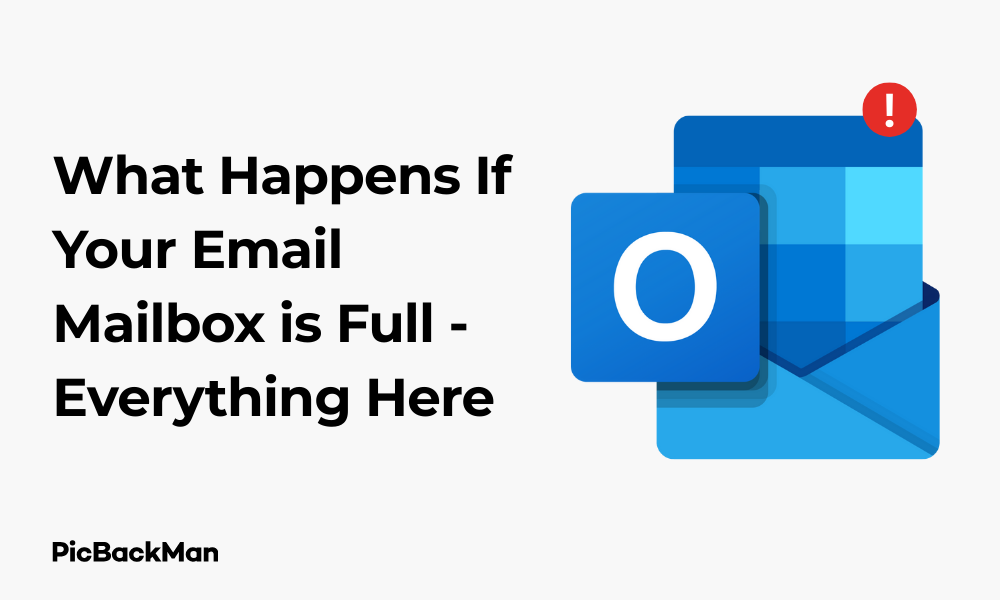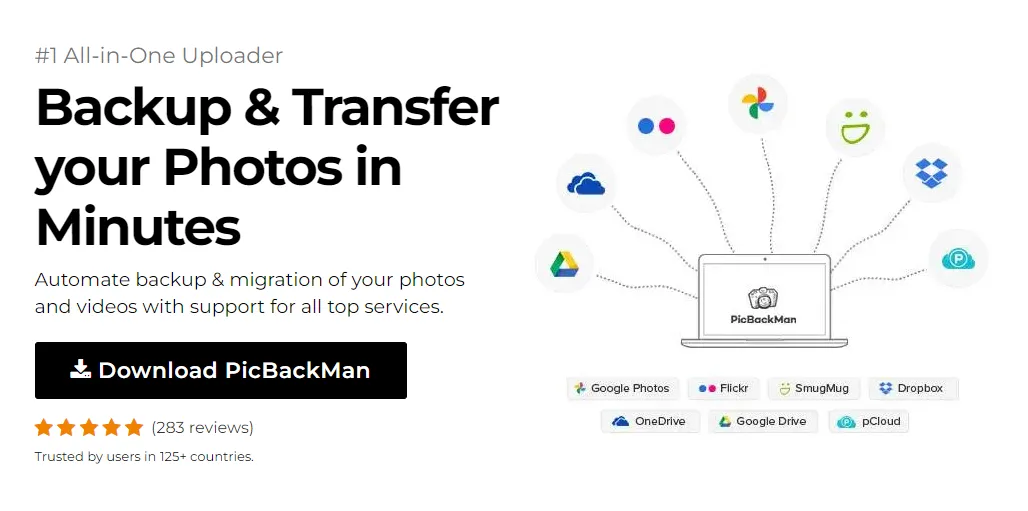
Why is it the #1 bulk uploader?
- Insanely fast!
- Maintains folder structure.
- 100% automated upload.
- Supports RAW files.
- Privacy default.
How can you get started?
Download PicBackMan and start free, then upgrade to annual or lifetime plan as per your needs. Join 100,000+ users who trust PicBackMan for keeping their precious memories safe in multiple online accounts.
“Your pictures are scattered. PicBackMan helps you bring order to your digital memories.”
What Happens If Your Email Mailbox is Full - Everything Here


Have you ever wondered what happens when your email inbox reaches its storage limit? We've all seen those notification warnings about our mailbox getting full, but many of us ignore them until it's too late. A full email mailbox can cause more problems than you might expect, from missed important messages to potential data loss.
In this complete guide, I'll walk you through everything that happens when your email storage maxes out, how it affects your communication, and simple steps to fix and prevent this common problem. Let's dive into the world of email storage limits and keep your digital communication flowing smoothly.
Signs Your Email Mailbox is Approaching Its Limit
Before your mailbox completely fills up, your email service provider typically sends warning signals. Recognizing these early warnings can save you from communication headaches down the road.
Common Warning Notifications
- Alert emails from your service provider
- Banner notifications when you log in
- Percentage indicators showing how full your mailbox is
- Color-coded warnings (often yellow for approaching limits, red for critical)
- Pop-up messages when sending or receiving emails
These warnings usually start appearing when you've reached about 90% of your storage limit. The exact threshold varies by provider, with Gmail, Outlook, and Yahoo each having their own notification systems.
Storage Limits by Popular Email Providers
| Email Provider | Free Account Storage | Paid Options |
|---|---|---|
| Gmail | 15 GB (shared with Google Drive) | 100 GB to 30 TB with Google One |
| Outlook/Hotmail | 15 GB | 50 GB to 1 TB with Microsoft 365 |
| Yahoo Mail | 1 TB | Yahoo Mail Pro removes ads but keeps same storage |
| AOL | 25 GB | Limited paid options |
| ProtonMail | 500 MB | 5 GB to 20 GB with paid plans |
What Actually Happens When Your Mailbox is Full
When your email storage limit is reached, several immediate consequences kick in that affect both incoming and outgoing messages.
Incoming Email Problems
The most obvious impact is on new messages trying to reach you. When someone tries to send you an email and your mailbox is full, here's what happens:
- The sender's email bounces back to them
- They receive an automated message like "Mailbox full" or "Quota exceeded"
- Your email server rejects the incoming message completely
- The message is held in a temporary queue (on some servers) for a limited time
- After the queue period expires, the message is permanently rejected
This bounce-back process means you'll never know someone tried to contact you unless they reach out through another channel. For business communications, this can mean missed opportunities, delayed project updates, or lost client inquiries.
Outgoing Email Limitations
Many people don't realize that a full mailbox also affects your ability to send emails:
- Some providers block outgoing emails when storage is full
- You may be unable to save drafts
- Sent emails might not be saved in your “Sent” folder
- Attachments may fail to upload when composing messages
- Auto-saving features may stop working
These limitations vary by email provider, but the general rule is that full storage restricts both incoming and outgoing email functionality.
Account Functionality Issues
Beyond basic email sending and receiving, other features of your email account may be compromised:
- Calendar invitations may not be received
- Notification emails for social media or other services won't arrive
- Auto-forwarding rules might stop working
- Email filters and sorting may become unreliable
- Search functionality might slow down or become less accurate
Long-Term Consequences of Ignoring a Full Mailbox
Letting your mailbox remain full for extended periods can lead to more serious problems beyond just missing a few messages.
Professional Reputation Impact
For professionals, a full mailbox sends a negative message to colleagues, clients, and contacts:
- It suggests poor digital organization skills
- Creates an impression of unreliability
- May indicate to clients that you're overwhelmed or understaffed
- Can make you appear technologically unsavvy
- Might suggest to employers or clients that you're not actively engaged
Potential Data Loss
Some email providers have policies regarding inactive or consistently full accounts:
- Accounts may be flagged as abandoned after certain periods
- Some providers delete emails from oldest to newest when space is needed
- Account recovery becomes more difficult if you exceed storage for too long
- Backups may stop being created for your account
- In extreme cases, providers might chronically deactivate full accounts
Security Vulnerabilities
A full mailbox can even create security weaknesses:
- Security alert emails won't reach you
- Password reset emails can't be delivered
- Two-factor authentication codes sent via email will bounce
- Notifications about suspicious account activity go undelivered
- System update information and security patches announcements are missed
How to Fix a Full Email Mailbox
If you've reached your storage limit, here are step-by-step solutions to quickly resolve the issue and get your email flowing again.
Immediate Steps to Free Up Space
- Delete large emails with attachments first (sort by size for efficiency)
- Empty your trash/deleted items folder completely
- Clear out your spam folder
- Remove emails from your sent folder that have large attachments
- Unsubscribe and delete newsletters and promotional emails in bulk
Using Email Management Tools
Most email providers offer built-in tools to help manage storage:
Gmail Storage Management
- Go to Gmail storage page at https://one.google.com/storage/management
- Click on the “Free up account storage” option
- Use search operators like "has:attachment larger:10mb" to find space-hogging emails
- Use the "Select all conversations that match this search" option to bulk delete
- Check the "Categories" tab to quickly find and delete promotional emails
Outlook Storage Management
- Use the "Cleanup Tools" option in the File menu
- Select "Mailbox Cleanup" to find large items
- Use the "View by Size" sorting option
- Run the "Mailbox Cleanup Tool" to archive old items
- Empty the "Deleted Items" folder which doesn't happen automatically
Yahoo Mail Storage Management
- Click on the "View" dropdown and select "Size"
- Use Smart Views to identify bulk mail and subscriptions
- Select the "Trash" option to empty deleted emails
- Use the search filter "has:attachment" to find emails with files
- Check the “Photos” view to delete image attachments quickly
Archiving Important Emails
Rather than deleting everything, archive important messages you want to keep:
- Download important emails as .eml or .msg files to your computer
- Export conversations to PDF for permanent records
- Use the archive function (especially in Gmail) to remove emails from inbox but keep them searchable
- Create local email archives using email clients like Thunderbird or Outlook
- Use third-party backup tools like MailStore Home or Mailbird
Preventing Future Email Storage Issues
Once you've fixed your immediate storage problem, implement these strategies to prevent it from happening again.
Regular Maintenance Habits
Develop these email hygiene practices:
- Schedule a monthly "email cleanup day"
- Delete unnecessary emails immediately after reading
- Unsubscribe from newsletters you no longer read
- Download and remove large attachments, storing them elsewhere
- Set calendar reminders to check your storage usage quarterly
Email Storage Upgrade Options
If you consistently need more space, consider these upgrade paths:
Comparing Paid Storage Plans
| Provider | Basic Paid Plan | Cost | Storage Increase | Additional Benefits |
|---|---|---|---|---|
| Google Workspace | Business Starter | $6/month per user | 30 GB | Custom email domain, video meetings, shared calendars |
| Microsoft 365 | Personal | $70/year | 50 GB email + 1 TB OneDrive | Office apps, advanced security |
| Google One | Basic | $20/year | 100 GB (shared) | Family sharing, Google expert support |
| Apple iCloud+ | 50 GB Plan | $0.99/month | 50 GB | Hide My Email, Custom Email Domain, HomeKit Secure Video |
| ProtonMail Plus | Plus | $4/month | 5 GB | 5 email addresses, custom domains, enhanced security |
Using Multiple Email Accounts strategically
Another approach is to distribute your email load across multiple accounts:
- Use separate accounts for personal and professional communications
- Create a dedicated account for subscriptions and newsletters
- Use a specific account for services that send large attachments
- Set up email forwarding between accounts for centralized checking
- Consider an “archive” email account for storing older emails you want to keep
Technical Details: How Email Storage Works
Understanding the technical aspects of email storage can help you manage it better.
What Counts Toward Your Storage Limit
Email storage calculations include more than just your visible inbox:
- Email body text (usually small unless very long)
- Attachments (often the biggest storage users)
- Images embedded in emails
- Emails in all folders, including sent items and drafts
- Trash and spam folders (until emptied)
- Email metadata (headers, routing information)
- Formatting and HTML code in fancy emails
How Different Providers Calculate Storage
Each email service has its own approach to storage limits:
- Gmail counts all Google services (Drive, Photos) against your limit
- Outlook.com separates email storage from OneDrive
- Yahoo provides generous 1TB storage focused mainly on email
- Business email accounts often have per-user quotes set by administrators
- Some providers count only the inbox against your quota, while others include all folders
IMAP vs. POP3: Storage Applications
Your email access method affects storage usage:
IMAP (Internet Message Access Protocol)
- Keeps emails on the server
- Syncs across all devices
- Counts towards your server storage limit
- Provides access to all folders from any device
- Better for multiple device users but uses more server storage
POP3 (Post Office Protocol)
- Downloads emails to your local device
- Can delete emails from server after downloading
- Reduces server storage usage
- Limited access across multiple devices
- Better for storage management but less convenient
Email Storage Management for Different User Types
Different email users have different storage needs and management approaches.
For Business Professionals
If you use email for work, consider these strategies:
- Implement a strict email filing system with folders for projects/clients
- Use cloud storage links instead of attachments for large files
- Export and archive completed project emails
- Request IT support for increased storage if needed for business purposes
- Consider a dedicated CRM system for customer communications
For Personal Users
Casual email users should focus on:
- Regular deletion of promotional emails
- Saving important photos and documents to a dedicated storage solution
- Using email search features rather than keeping everything "just in case"
- Setting up automatic filters to categorize incoming mail
- Considering free alternatives if you consistently hit storage limits
For Heavy Email Users
If you receive hundreds of emails daily:
- Invest in a paid email service with higher storage limits
- Use email management tools like SaneBox or Clean Email
- Set up aggressive filtering rules to sort incoming mail
- Consider local backup solutions for archiving
- Regularly export and delete old email conversations
Email Alternatives for File Sharing and Storage
One major cause of email bloat is using it for purposes better served by other tools.
Cloud Storage Options
For sharing files that would otherwise log your email:
- Google Drive: 15GB free storage with excellent sharing options
- Dropbox: Simple interface with 2GB free storage
- Microsoft OneDrive: 5GB free with Office integration
- Box: Business-focused storage with free personal tier
- iCloud: Apple ecosystem integration with 5GB free
Messaging Platforms for Communication
For quick conversations that don't need to log your inbox:
- Slack: Team-based messaging with file sharing
- Microsoft Teams: Integrated with Office 365 environment
- Discord: Community-focused with voice and text
- WhatsApp: Personal messaging with end-to-end encryption
- Telegram: Feature-rich messaging with large file sharing
Project Management Tools
For collaborative work that generates lots of back-and-forth emails:
- Trello: Visual board-based project tracking
- Asana: Task-focused project management
- Monday.com: Versatile work management platform
- Notion: All-in-one workspace for notes and projects
- ClickUp: Comprehensive project and task management
Quick Tip to ensure your videos never go missing
Videos are precious memories and all of us never want to lose them to hard disk crashes or missing drives. PicBackMan is the easiest and simplest way to keep your videos safely backed up in one or more online accounts.
Simply download PicBackMan (it's free!) , register your account, connect to your online store and tell PicBackMan where your videos are - PicBackMan does the rest, automatically. It bulk uploads all videos and keeps looking for new ones and uploads those too. You don't have to ever touch it.
Legal and Privacy Considerations
There are some important legal aspects to consider regarding email storage.
Data Retention Requirements
Some industries have specific email retention rules:
- Financial services: Often required to keep emails for 7+ years
- Healthcare: HIPAA requirements for patient communications
- Legal: Case-related communications may need permanent archiving
- Government: Public records laws may apply to email
- Publicly traded companies: SEC requirements for business records
Privacy Implications
Your email storage choices affect your privacy:
- Emails contain personal data subject to privacy regulations such as GDPR
- Free email services often scan content for advertising purposes
- Local storage gives you more control but less backup protection
- Cloud storage provides convenience but puts data on third-party servers
- Deleted emails may still be recoverable by service providers
Conclusion
A full email mailbox is more than just an annoyance—it's a communication breakdown that can have serious personal and professional consequences. From bounced messages and missed opportunities to potential data loss and security vulnerabilities, the impacts are far-reaching.
The good news is that managing your email storage is relatively straightforward once you understand what's happening. By implementing regular maintenance habits, strategically archiving important messages, and leveraging the right tools, you can keep your digital communication flowing smoothly.
Remember that email was designed for correspondence, not storage. By using dedicated solutions for file storage, messaging, and project management, you'll not only solve your storage problems but also improve your overall digital workflow. Whether you choose to upgrade your storage, better organize your existing space, or distribute your communication across multiple platforms, taking action now prevents headaches later.
Frequently Asked Questions
How long will emails bounce back if my mailbox is full?
When your mailbox is full, emails will typically bounce back immediately to the sender. The sending server usually tries to deliver the message for 24-72 hours with multiple retry attempts before sending a permanent failure notification. After this period, the message is returned to the sender with a delivery failure notice, and you'll have no record that someone tried to contact you.
Can I recover emails that bounced because my mailbox was full?
Unfortunately, you cannot directly recover emails that bounced due to a full mailbox. These messages never reached your server and were returned to the sender. Your only option is to contact the sender and ask them to resend the message after you've cleared some space. This is why it's crucial to address storage warnings promptly before important messages get rejected.
Will upgrading my storage plan recover emails I missed?
No, upgrading your storage plan will not recover emails that were rejected while your mailbox was full. Upgrading only prevents future emails from bouncing by providing more storage space. Any messages that bounced before the upgrade are gone from your system and would need to be resent by the original senders.
Do attachments I've already opened still take up space?
Yes, attachments continue to take up space in your email storage even after you've opened or downloaded them. Opening an attachment creates a local copy on your device but doesn't remove it from the email server. To free up space, you need to either delete the email containing the attachment or save the attachment elsewhere and delete it from the email.
If I delete emails from my phone, are they deleted from my computer too?
It depends on your email setup. If you're using IMAP (which most modern email services use), then yes—deleting emails on your phone will sync across all devices. If you're using POP3, deletions may only happen on the device where you deleted them. To ensure consistent storage management, check your email settings and confirm you're using IMAP if you access email from multiple devices.






